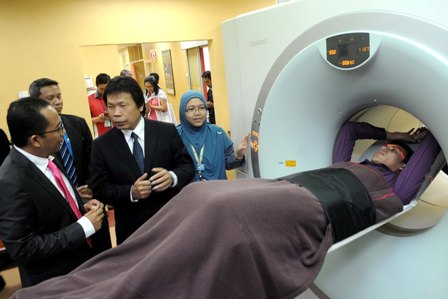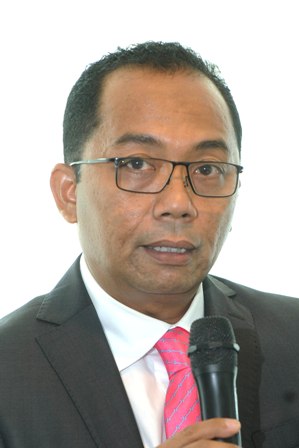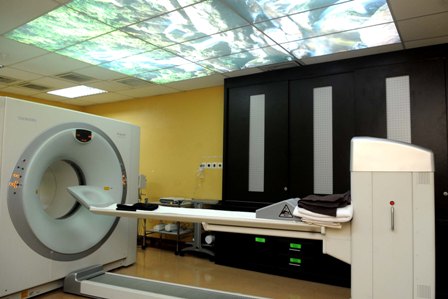By Kuah Guan Oo
Pic By Puan Marina Ismail

SERDANG, 3 June (UPM) – Cancer may be a deadly disease that silently attacks our organs but it may not escape the eyes of trained radiologists and doctors like those at the Centre for Diagnostic Nuclear Imaging (CDNI) of Universiti Putra Malaysia (UPM).
And this is because they have the state-of-the-art PET-CT machine that allows them to see in 3-D, cross-sections of the anatomy of the body, from head to toe.
From the “slices” of the body they can, with their trained eyes and database, detect any abnormal cellular changes and activities and tell you with the highest level of accuracy possible if a particular organ could be troubled, said the head of CDNI (Pusat Pengimejan Diagnostik Nuklear, Prof Dr Abdul Jalil Nordin at a media briefing and tour here today.

He said the non-invasive body scan by the PET-CT machine would allow the doctors to zoom in to the troubled spot for a PET-CT guided biopsy to ascertain whether if it is cancerous and to apply the early treatment and remedy (see www.ppdn.upm.edu.my).
“Like any other diseases, early detection and treatment would make for better cure,” he said as he unveiled for the facility to the media for the first time at the Faculty of Medicine and Health Sciences of UPM.
The CDNI was mooted under the 9th Malaysia Pelan in 2008 and on 1st April 2010, it started operation with the first PET-CT equipment installed under the then Ministry of Higher Education for diagnostic, training and research purposes.
The centre had scanned about 500 patients since opening its doors and to date, it has grown to provide clinical services in oncology, infection, inflammation, cardiology and neurology.
What makes the CDNI different is that it is a one-stop centre where its state-of-the-art medical devices like Magnetic Resonance (MR) and Hybrid Modalities (PET-CT, molecular-MR and SPECT-CT) allow for early detection of diseases, monitoring treatments and follow up.
The fees, depending on the services required, can be as low as RM80 to RM2,000 for a full-body PET-CT scan, much cheaper than the other 9 private hospitals with similar PET-CT equipment in the country.

Prof Dr Jalil said CDNI takes in only patients who are referred to them by other doctors and the waiting time for a PET-CT appointment is usually within a week and the results comprising official reports and images are provided within 24 hours.
With ensuite facility to rest before and after the PET CT imaging session, the patient and close relatives are given free consultation entailing the PET and CT findings
CDNI is divided into two main units – clinical and pre-clinical & technical – where each unit is further divided into 4 divisions, that is, oncology imaging, infection/inflammatory imaging, cardiovascular imaging and neurology imaging.
“The clinical unit coordinates clinical services involving medical specialists in Diagnostic Imaging (Radiologists), Clinical Oncologist, Microbiologist, Pathologist, Cardiologist, Neurologist and Surgeons.
“The Pre-Clinical and Technical Unit coordinates activities other than clinical medicine,” said the medical doctor who was trained in Universiti Kebangsaan Malaysia (UKM) in 1989 before getting his Masters in Radiology from Universiti Malaya in 1996. He went on to obtain his Fellowship in Nuclear Medicine from University of Sydney (Westmead Hospital) in 1997 and a Fellowship in PET-CT from the University of Zurich in 2008.
CDNI is recognised and accredited through its network of cooperation with international institutions with experts in PET-CT and MRI, including the University of Milan Bicocca and Ospedale Niguarda, Italy; the Medical University of Innsbruck. Austria; University Medical Centre Groningen, Netherlands; University Hospital Zurich, Switzerland and the Peter McCallum Cancer Centre of Melbourne, Australia.
Prof Dr Jalil said from their research, they found that there is a close relationship between Chronic Diabetes Mellitus (CDM) and Coronary Artery circulation.
“In the near future, the Centre will start non-FDG tracer imaging and new drug and tracer development projects involving scientists from various disciplines,” he said, adding that they would continue to train the medical and technical personnel besides nurses in nuclear diagnostic imaging.
Asked if he would advise people to include PET-CT in their regular medical check-ups, he said he would recommend that those with a family history of cancer.
“The PET CT scan has the highest degree of accuracy, and it would be cost-effective in the long run if a person needs a battery of other tests and scans, ” he said . – UPM/kgo
Date of Input: |
Updated: | amir_peli
MEDIA SHARING



























